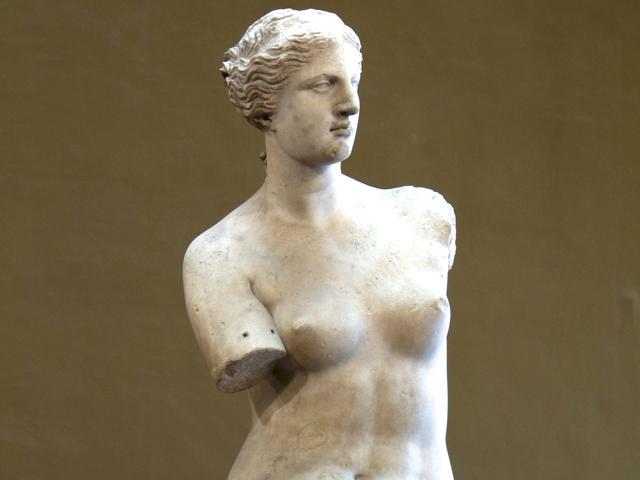Venus de Milo

Aphrodite, 2nd century BC.
Despite its Roman name, this sculpture is in fact Greek. Discovered in 1820 in “Mélos” (or Milo in modern Greek), an island at the Athens coast, it was bought by the Marquis de Rivière before it was taken to the Ottoman Empire and then given to King Louis XVIII as a gift. It was probably sculpted in 130 BC by an unknown artisan. While her half-nakedness suggests that she is the goddess of love, her identity is not certain.
You are looking at white marble, but that was painted! You can still see the remaining traces of red/orange colours on her dress. She was sacred, thus in ancient times, people would have worshipped her. Her strong presence and sense of movement would have left people impressed. The artisan goes back to the classical art of the 5th and 4th centuries BC for inspiration, while also bringing new ways of representing movement through the position of the goddess.
Her left leg moves outward while the weight of the goddess is placed on her right leg. This is a very relaxed and powerful pose that creates both a feeling of serenity and dynamism, which is known as Contrapposto. Aphrodite’s body is perfectly proportioned and characterizes the Hellenistic period.
Composed of two marble blocks, the union can be seen at the level of her skirt. The arms of the goddess were sculpted separately and were once attached to the body with metal joints. Neither of her arms have ever been found, but her left hand is likely to have held an apple, alluding to the Judgment of Paris (if she is really Aphrodite), while her right hand may have been holding her dress or covering part of her chest. The two holes that can be seen in her remaining right arm could have been used to hold metal jewelry. She could have also worn a headband, necklace and earrings.
Greek sculptures are very rare! Therefore, this is one of the most important exhibits in the Louvre. If we study her closely, she is gazing over the many Roman copies of Venus in the room directly in front of her.
© Tourblink